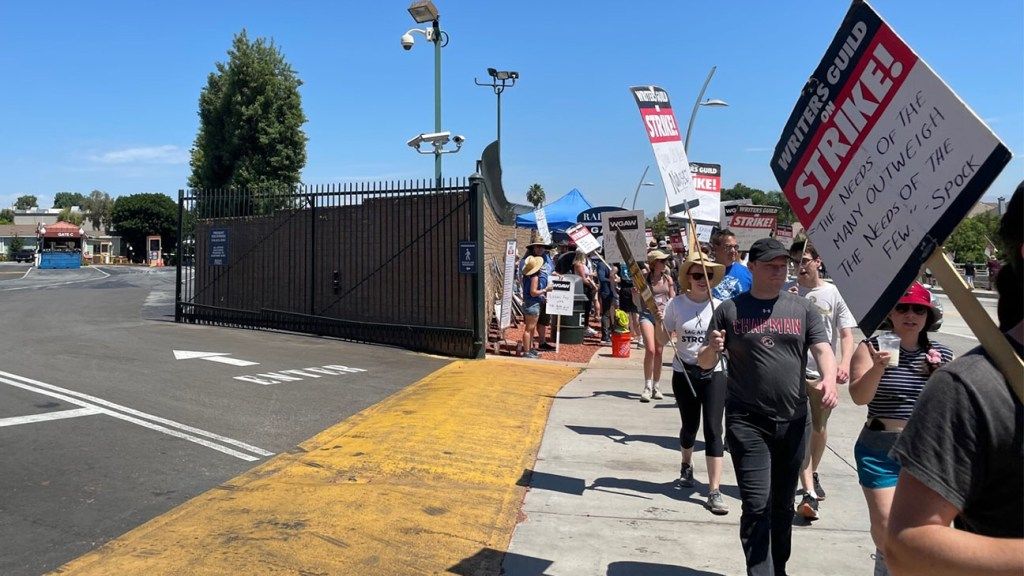The Hollywood Reporter
A week after filing National Labor Relations Board grievances against NBCUniversal, the two striking Hollywood unions are reaching their limit at another picketing location three miles west in the San Fernando Valley: Radford Studio Center.
The Writers Guild of America, now on the cusp of marking its third month on strike against the Alliance of Motion Picture and Television Producers, and performers organization SAG-AFTRA, which is two weeks into a work stoppage over its own contract dispute against the same studio association, both allege that Radford’s ownership has deprived them of their constitutional right to protest at the site safely and fairly.
Hackman Capital Partners — a Los Angeles-based real estate investment and operations firm with, by its own account, more than $10 billion in overall assets and a global reach in properties focused on film and television production — owns the historic 55-acre facility. Its other U.S. holdings include Silvercup Studios in Long Island City, Second Line Stages in New Orleans and Raleigh Studios in Hollywood. While Hackman isn’t a member of the AMPTP, many of its tenants are, hence the picketing. At Radford, one struck company, Paramount/CBS, dominates the lot, while Apple also has a presence.
The conflict is over where picketing is allowed. During the 2007 WGA strike, when ViacomCBS still owned the lot (it sold to Hackman in 2021 for $1.85 billion), members marched along tree-lined Radford Ave., the campus’ western boundary — which features the main entrance, utilized by talent and executives. In May, when the current walkout began, Hackman marked all four gates on Radford Ave. as “neutral,” meaning they’re strictly for the use of tenants not involved in the union dispute, such as Will Ferrell’s Gloria Sanchez Productions and Sid & Marty Krofft Pictures. The strikers could only protest at a single, auxiliary gate in the back, which facilitates the arrival of live-audience members as well as service workers. This eastern gate, just north of Ventura Blvd. where an equally busy stretch of Colfax Ave. begins to cross over the L.A. River, features a narrow strip of sidewalk and zero shade.
The WGA says it has unsuccessfully solicited an explanation from Hackman for its determination. Theories circulate on the picket line. That the sight and sound of protestors are purposefully being kept as far as possible from the facility’s office workers — and, even more crucially, residents of the immediate neighborhood whom ownership needs to cultivate amid a high-stakes ongoing government approval process for a billion-dollar campus upgrade. Or else, perhaps, it’s just retribution, to make things uncomfortable for a group which has made their clients uncomfortable, whether party or not party to the AMPTP dispute.
The main entrance of Radford Studio Center along Radford Ave. in Studio City on July 25. Property owner Hackman Capital Partners has marked it as a “neutral” gate, so picketers can’t legally protest there. Gary Baum/THR Staff
Officially, the WGA’s executive leadership won’t speculate about the motivation. However, a spokesperson tells The Hollywood Reporter in a statement that “we are committed to the safety of our members and have not ruled out the possibility of legal action.”
In its own statement SAG-AFTRA, which has yet to formally send members to picket at the location (although some have gone on their own), noted: “We are appalled that yet another studio has decided to relegate peaceful picketers, who have made enormous profits for them for decades, to unsafe picketing conditions, and we are investigating all legal options that would hold them accountable and enforce our members’ constitutional rights.” (SAG-AFTRA previously cited troubling street conditions at NBCUniversal, particularly during the current heatwave, as having “forced” the union “to determine that it cannot safely send its members” out to that studio.)
Hackman declined to explain its gate rationale. “Radford Studio Center supports the unions’ lawful right to picket our facility,” said Radford Studio Center president Michael Klausman in a statement provided to THR. “The studio has offered to supply WGA and SAG-AFTRA strikers with shade structures, food, and water and will continue to do so.” (The WGA notes that it’s not aware of any such offer.) Klausman went on: “While Radford Studio Center is not a member of the AMPTP and therefore not party to any of the ongoing negotiations, we support the entertainment industry as Los Angeles’ signature industry and hope the strikes are resolved quickly.”
Attorney Andrew MacDonald, co-chair of the labor management relations practice at Fox Rothschild, which represents clients in the construction industry, notes that employers “have full discretion” over selecting which gates at their work site will be designated neutral, and that the history of their use prior to a walkout is irrelevant. What matters, from the NLRB’s perspective, is whether employers and other pertinent parties are utilizing them neutrally during a strike action. “This is the issue that’s litigated all the time,” he says, and is why unions are allowed to place eagle-eyed observers outside gates to document who is entering and exiting, as the WGA has been doing from the outset at each ostensibly neutral point it pickets. The evidence can then potentially be evaluated by the NLRB to determine if a gate has been misused and may no longer be deemed neutral. (Dare Me co-showrunner Gina Fattore, who’s been marking vehicles heading in and out of Radford since the onset of the strike, notes vehicle volume is now down more than 40 percent.)
Wilma B. Liebman, a leading authority on labor law and longtime NLRB board member who was designated its chair by President Barack Obama, sees the remoteness of the Colfax Ave. gate as perhaps the unions’ strongest legal argument. She points to court precedent which has established that neutral gate designations can’t unreasonably impair unions’ picketing effectiveness, especially by constraining protesting to locations so distant from an employer’s personnel, suppliers, visitors, and the general public as to be effectively hidden. As for other factors, like space for marching and availability of shade, Liebman observes that they’d likely “go into the factual mix” of a NLRB decision.
The WGA’s Radford lot captain Andra Whipple claims she recently took a 116-degree temperature reading on the exposed Colfax Ave. pavement, while a shadowed portion of sidewalk along Radford Ave. read 86 degrees. Charlie Kelly, a WGA assistant lot coordinator at Radford who, before the work stoppage, was writing on The Great North, muses of Hackman: “They say they are neutral but they have definitely chosen to cook us alive, like burgers on a grill. It doesn’t feel neutral out here.”
Whipple, who counts more than 100 strikers at Radford on a typical day, doesn’t dispute that Hackman retains discretion to implement its gate system — “but they’ve chosen to do it in a suspicious and dangerous way,” she contends, believing that the limited available protesting area makes it perilous for those with heat intolerance as well as those bringing small children to join the effort, and that SAG-AFTRA may feel there’s simply not enough space for its own exponentially larger membership to join in.
The lot — founded nearly a century ago as Mack Sennett Studios by the legendary silent film producer and director — was first a production home for Westerns starring John Wayne, Gene Autry and Roy Rogers before becoming a TV era nexus for now-classic multi-camera sitcoms including The Mary Tyler Moore Show, Gilligan’s Island and Leave It To Beaver. In more recent decades Seinfeld, Will & Grace and That 70’s Show were shot at Radford. The Conners is among the shows that had been utilizing the more than 20 sound stages until the strikes put a stop to production.
While other networks have utilized the facility, CBS has been most closely identified with it. (Prior to the 2021 sale, it was known as CBS Studio City.) KCBS-TV and its sister KCAL-TV affiliate moved on-site after vacating Hollywood’s historic Columbia Square in 2007, and the national CBS Evening News sometimes is anchored from the property.
In February, Hackman announced a $1 billion plan to upgrade and enlarge the complex. The multiyear project, submitted to Los Angeles officials and requiring the approval of various stakeholders — most importantly, influential residential groups — includes the addition of one million square feet of soundstages, offices, and production facilities.
Patti Carr, a WGA Radford coordinator, says she doesn’t understand Hackman’s position, at least if being a conscientious neighbor, even for expedience, is on its mind. After all, as a local (she lives a few blocks away) who’s long worked on the lot — “my first show was Boy Meets World” — she notes of the adjacent community: “It’s full of WGA and SAG members! We’re the ones who are trying to picket, right here in our own backyard.”
Source: Hollywood Reporter


